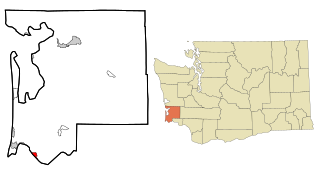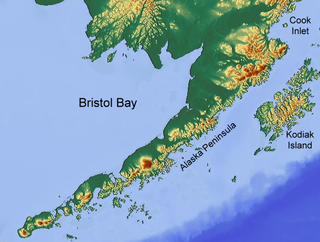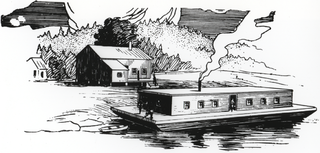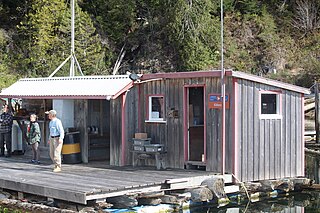
Wahkiakum County is a county located in the U.S. state of Washington. As of the 2020 census, the population was 4,422, making it one of the least populous counties in Washington. The county seat and only incorporated town is Cathlamet. The county was formed out of Cowlitz County in April 1854 and is named for Chief Wahkiakum of the Chinook, who is buried in the Pioneer Cemetery in Cathlamet.

Dillingham, also known as Curyung, is a city in Dillingham Census Area, Alaska, United States. Incorporated in 1963, it is an important commercial fishing port on Nushagak Bay. As of the 2020 census, the population of the city was 2,249, down from 2,329 in 2010.

Petersburg is a census-designated place (CDP) in and essentially the borough seat of Petersburg Borough, Alaska, United States. The population was 3,043 at the 2020 census, up from 2,948 in 2010.

Pacific City is a census-designated place (CDP) and unincorporated community in Tillamook County, Oregon, United States. The population was 1,109 at the 2020 census. Pacific City is home to the Cape Kiwanda State Natural Area.

Camas is a city in Clark County, Washington, with a population of 26,065 at the 2020 census. The east side of town borders the city of Washougal, Washington, and the west side of town borders Vancouver, Washington. Camas lies along the Washington side of the Columbia River, across from Troutdale, Oregon, and is part of the Portland metropolitan area.

Chinook is a census-designated place (CDP) in Pacific County, Washington, United States. The population was 457 at the 2020 census.
Grays River is a tributary of the Columbia River, approximately 30 miles (48 km) long, in southwestern Washington in the United States. One of the last tributaries of the Columbia on the Washington side, it drains an area of low hills north of the mouth of the river.

Bristol Bay is the easternmost arm of the Bering Sea, at 57° to 59° North 157° to 162° West in Southwest Alaska. Bristol Bay is 400 km (250 mi) long and 290 km (180 mi) wide at its mouth. A number of rivers flow into the bay, including the Cinder, Egegik, Igushik, Kvichak, Meshik, Nushagak, Naknek, Togiak, and Ugashik.

Westport is an unincorporated community and census-designated place on the Columbia River in Clatsop County, Oregon, United States. As of the 2010 census, it had a population of 321.
The Ilwaco Railway and Navigation Company operated a 3 ft narrow gauge railroad that ran for over forty years from the bar of the Columbia River up the Long Beach Peninsula to Nahcotta, Washington, on Willapa Bay. The line ran entirely in Pacific County, Washington, and had no connection to any outside rail line. The railroad had a number of nicknames, including the "Clamshell Railroad" and the "Irregular, Rambling and Never-Get-There Railroad."

McGowan was a stop on the Ilwaco Railway and Navigation Company's narrow gauge line that ran on the Long Beach Peninsula in Pacific County, Washington, United States from 1889 to 1930. In the late 19th century, P.J. McGowan bought land in the area for $1,200, and built his house, a dock and a salmon cannery on the site. During the railroad times, the main line and a passing siding ran through McGowan. McGowan is just west of the north end of the Astoria-Megler Bridge. The only prominent structure remaining is the old wooden Roman Catholic church. From 1925 to 1932, one of the docks of the Astoria-Megler Ferry route was located at McGowan.

Taku Harbor is a sheltered bay located about 22 miles (35 km) southeast of central Juneau, Alaska, United States. With proximity to the Taku River, the harbor served as important center of trade for the Taku people, as a Hudson's Bay Company trading post, and salmon cannery. Currently nearly all of the harbor is part of the Taku Harbor State Marine Park. There are no current year-round residents.

A salmon cannery is a factory that commercially cans salmon. It is a fish-processing industry that became established on the Pacific coast of North America during the 19th century, and subsequently expanded to other parts of the world that had easy access to salmon.

The Astoria–Megler ferry, also called the Astoria–McGowan ferry and the Astoria–North Beach ferry, ran across the Columbia River between Astoria, Oregon, and two ferry docks near the present small community of Megler, Washington, from 1921 to 1966.
Altoona is a census-designated place (CDP) in Wahkiakum County, Washington, approximately 27 miles northwest of the town of Cathlamet. The population was 39 as of the 2010 census. The CDP includes the communities of Carlson Landing and Dahlia.

Joseph George Megler, generally known as J.G. Megler, was a German-American salmon cannery owner and politician in Washington. He was a member of the Washington House of Representatives for the first legislature in 1889 and five terms thereafter. He was also a member of the Washington State Senate for two terms.

Kildonan is an unincorporated community in the Alberni Inlet-Barkley Sound region of the west coast of southern Vancouver Island, British Columbia. The former steamboat landing and ferry dock is on the east shore of Uchuchklesit Inlet, which branches northwest of the lower reaches of Alberni Inlet. Adjacent to Pacific Rim National Park Reserve, the locality is by road and ferry about 120 kilometres (75 mi) southwest of Port Alberni.
Puget Sound fishermen's strike of 1949 was a labor strike by fishermen in the Pacific Northwest.

Harlows Creek is a stream in Wahkiakum County in the U.S. state of Washington. The name of the stream used to be Jim Crow Creek until it was changed by the U.S. Board of Geographic Names effective May 10, 2017 as part of an nationwide effort to remove offensive and/or derogatory names from geographic features. The new name commemorates John (1872-1953) and Mary (1888-1963) Harlow, who lived in the area during the 1870s.

Hapgood-Hume Company was a Salmon cannery and now a historical site in West Sacramento, California in Yolo County. The site of the former Hapgood-Hume Company is a California Historical Landmark No. 1040 listed on April 1, 2009. The Hapgood-Hume Company was the First Pacific Coast Salmon Cannery founded on April 1, 1864, on the Sacramento River, closed in 1873 in Washington state. The site of the Hapgood-Hume Company was a National Register of Historic Places, #66000938, from April 6, 1964, to July 14, 2004. The Hapgood-Hume Company was formed by Robert Deniston Hume, William Hume, John Hume, and George Hume, with a friend Andrew Hapgood. All of founders of the company came from Maine. Hapgood had been a tinsmith and a fisherman in Maine, arriving in California in 1864.

















